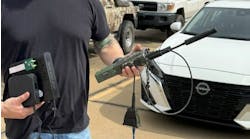Indicated vs. Applied Battery
Low Meter Impedance Causes Cross Battery Voltage Errors
There is a considerable amount of confusion that takes place when testing vacant circuits tip and ring to ground to determine the amount of crossed battery on a faulted conductor, and if this crossed battery will affect customer service.
Because voltmeters are always hooked up to a circuit in parallel, they become part of the circuit and reduce the total resistance of the circuit. If a voltmeter has a resistance that is too low in comparison to the circuit it will give a false measurement.
The false reading is due to the meter changing the makeup of the circuit by lowering the resistance which increases the current flow in the circuit. The effect a voltmeter has on the circuit to which it is attached is referred to as the loading effect of the meter.
The loading effect of a voltmeter on a circuit is determined by the total resistance of the circuit in relation to the impedance of the voltmeter. Every voltmeter has impedance which is the meter’s internal resistance.
The impedance of an analog voltmeter is referred to in ohms per volt. The amount of internal resistance an analog voltmeter represents to the circuit changes depending upon the selected scale.
Digital meters have a fixed resistance which does not change from scale to scale and is usually 10 Megohms or more. Impedance is the biggest dissimilarity between analog and digital voltmeters. Because most digital voltmeters have at least 10 times more impedance than analog voltmeters, digital voltmeters load the circuit less when measuring high resistance faults.
A 10 Megohm digital meter loads the circuit less, but in telephony, consistency in comparison between meters is more important. We want to use a 1 Megohm internal meter resistance to maintain consistency in readings when compared to your other test sets, and not to chase foreign battery from normal leakage on good pairs.
For example, a 10 Megohm meter would see 1 Volt from a 500 Megohm cross, unquestionably not a case of trouble we should be chasing. We have found Digital Volt Meters used in the lab and by electricians are not able to accurately measure ohms on telephone pairs, and their 10 Megohm impedance gives cross battery voltages that indicate trouble when there isn’t any.
If you are using a low impedance (1,000 ohms per volt) KS8455 analog meter in the 100 volt scale (the voltmeter represents 100,000 ohms resistance to the circuit) to measure a 1,000,000 ohm battery cross in a circuit, the meter impedance forms a voltage divider with the circuit resistance.
You are not measuring just that fault but the fault plus your meter giving you a false reading of the actual voltage drop across the fault. This might lead you to think that the cross battery reading is acceptably low, when it is just the meter you are using. We all know a 1 Megohm cross is something we should fix.
If you use a meter such as a Sidekick with 1,000,000 Ohms of impedance to test the same fault only 1/10th of the current will flow through the meter which means the meter has very little effect on the circuit being measured.
Confusion for the Field Technician
When I started in the maintenance business I first used the analog Ohmmeter on the Western Electric breakdown test set and then the Western Electric KS8455 VOM. The ohm per volt network was low impedance (1,000 ohms/volt), the 100 Volt scale thus had only 100,000 ohms internal resistance, but most circuit faults were low resistance.
Testing Pulp and Paper Cables With a Low Ohms/Volt Meter
Most telephone cables that I worked on were pulp or paper insulated. Plastic insulation on conductors (PIC) was in its infancy. Multiple faults occurred when splices went wet, degradation of lead sheath aerial cables, squirrel bites, ring cuts, and so on. There were exceptions to the rule.
When a paper or pulp cable gets wet, it becomes a voltage divider. When testing any vacant conductor (tip or ring to ground) one-half (1/2) of the applied 48 to 56 volts (depending on the applied battery source of the individual switch) goes through the meter and the other half returns to ground through all working tips and the voltmeter indicates -25 volts. Since the wet pulp has low resistance you will get the same -25 Volt reading with a 100k ohm KS Meter as with a 1 Megohm Sidekick.
Wet porcelain face plates on fixed count terminals with higher resistance in the Megohm range indicated low battery in the -5 to -10 volt range because of the low ohms/volt network. Through repetition we learned to identify the root cause of low indicated battery. Such high resistance crosses will show a very low cross battery reading with the KS8455, and a more desirable higher cross battery reading with a 1 Megohm Sidekick.
Testing Plastic Insulated Conductors (PIC) With a Low Ohms/Volt Meter
Multiple faults on PIC cable occurred primarily because of water ingress into sections of air-core PIC cables and water ingress into splices. Series resistance through water averages from 270,000 ohms to around 10,000 ohms. The more resistance in series the lower the indicated foreign battery is displayed on the meter.
The low ohms/volt meters became ineffective and most companies shifted from the KS8455 to a higher ohms/volt meter. The 310 Triplett meter with a higher 20,000 ohms/volt network and 1,200,000 ohms internal impedance on the 60 Volt scale became the meter of choice. The higher ohms/volt network allowed technicians to identify and repair problems before they became service-affecting.
Testing With a High Impedance (1,000,000) Voltmeter
The high impedance voltmeter is a tremendous asset to the proactive telco teams. They are capable of identifying and locating high resistance faults 4 to 6 weeks before their customer would be affected; these faults are invisible to the customer.
The high impedance voltmeter is the bane of the reactive telco teams. For an already beleaguered team transferring service to other circuits, more work is in store. More pairs show faults and more dispatches are in order.
Those reactive folks want to go back to a low impedance 100,000 ohms/volt meter and test more pairs good and have less dispatches. You folks are correct. You can also hoodwink your state Public Utility Commissions.
But, when you don’t provide your customer a quality circuit, even if you get a test OK, because of the static your customer will go to the competitor, the crossed battery will go away, and your dispatches will decrease only because of fewer customers.
The McCarty Take on Low Impedance Meters vs. High Impedance Meters
No matter what the voltmeter shows, because there is series resistance in the fault, if the applied voltage is -51 VDC the faulted conductor is crossed with an applied voltage of -51 VDC. If nothing is done to fix the problem the static will get louder and eventually the conductor will go open.
If the circuit is moved to another circuit the other customer will complain because of unacceptable balance.
Telephone companies pay field technicians great deals of money to find and fix unacceptable paths between cable pairs. When the unwanted path is repaired the vacant circuit will test 0 volts tip and ring to ground. What is acceptable? Nothing other than 0 volts is acceptable.
I don’t think we will normally see absolute zero on a good cable. And if there is not water causing the leakage, high Megohm leakage will not have electrolysis to cause rapid deterioration. 16,000 feet of brand new plastic insulation will have some leakage. I think most techs know that below 1 Volt of cross battery on a pair is pretty good. 1 Volt would equate to a 50 Megohm cross.




